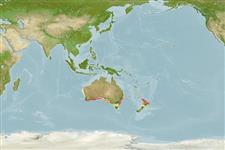Environment: milieu / climate zone / depth range / distribution range
Ecology
Marine; demersal; depth range 105 - 150 m (Ref. 82446). Temperate
Southwest Pacific: Australia.
Size / Weight / Age
Maturity: Lm ? range ? - ? cm
Max length : 4.5 cm SL male/unsexed; (Ref. 82446)
Short description
Morphology | Morphometrics
Dorsal
soft rays
(total): 17-18;
Anal
soft rays: 7 - 8. This species is characterized by the following combination of characters: large esca, size variable, about 56% of illicium length; thick illicium, fleshy, with some dermal spinules on basal half, length 16-21% SL, 2.1-3 times in head length; esca with similar thickness to rest of structure; body entirely covered with close-set, non-imbricate scales; scale bases rudimentary, margins irregular, with long bifurcate spinules (except for those closely associated with pores of the acoustico-lateralis system); mainly adpressed spinules, originating from posterior region of scale base, apical spines moderately divergent; second dorsal fin rays 15-16, fin base 61-66% SL; length of second dorsal-fin spine 0.8-0.9 times length of longest ray of second dorsal fin; anal-fin rays 7-8; pectoral-fin rays 7-8; upper body is uniformly pale pink; membranes between distal portions of rays of dorsal, caudal and pelvic fins dark (Ref. 82446).
Life cycle and mating behavior
Maturity | Reproduction | Spawning | Eggs | Fecundity | Larvae
Last, P. and D.C. Gledhill, 2009. A revision of the Australian handfishes (Lophiiformes: Brachionichthyidae), with descriptions of three new genera and nine new species. Zootaxa 2252:1-77. (Ref. 82446)
IUCN Red List Status (Ref. 130435)
Threat to humans
Harmless
Human uses
More information
Common namesSynonymsMetabolismPredatorsEcotoxicologyReproductionMaturitySpawningSpawning aggregationFecundityEggsEgg development
Age/SizeGrowthLength-weightLength-lengthLength-frequenciesMorphometricsMorphologyLarvaeLarval dynamicsRecruitmentAbundanceBRUVS
ReferencesAquacultureAquaculture profileStrainsGeneticsElectrophoresesHeritabilityDiseasesProcessingNutrientsMass conversion
Tools
Special reports
Download XML
Internet sources
Estimates based on models
Preferred temperature (Ref.
123201): 14.8 - 17.1, mean 15.5 °C (based on 6 cells).
Phylogenetic diversity index (Ref.
82804): PD
50 = 0.6251 [Uniqueness, from 0.5 = low to 2.0 = high].
Bayesian length-weight: a=0.00389 (0.00180 - 0.00842), b=3.12 (2.94 - 3.30), in cm total length, based on all LWR estimates for this body shape (Ref.
93245).
Trophic level (Ref.
69278): 3.4 ±0.6 se; based on size and trophs of closest relatives
Fishing Vulnerability (Ref.
59153): Low vulnerability (10 of 100).
